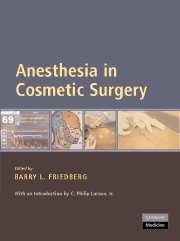Book contents
- Frontmatter
- Contents
- Foreword
- Acknowledgments
- Introduction
- Preface
- List of Contributors
- PART I MINIMALLY INVASIVE ANESTHESIA (MIA)Ⓡ FOR MINIMALLY INVASIVE SURGERY
- 1 Propofol Ketamine with Bispectral Index (BIS) Monitoring
- 2 Preoperative Instructions and Intraoperative Environment
- 3 Level-of-Consciousness Monitoring
- 4 The Dissociative Effect and Preemptive Analgesia
- 5 Special Needs of Cosmetic Dental Patients
- 6 Propofol Ketamine in the UK, Propofol Ketamine Beyond Cosmetic Surgery
- 7 Propofol Ketamine Beyond Cosmetic Surgery: Implications for Military Medicine and Mass-Casualty Anesthesia
- 8 Lidocaine Use and Toxicity in Cosmetic Surgery
- 9 Local Anesthetic Blocks in Head and Neck Surgery
- 10 Local Anesthetics and Surgical Considerations for Body Contouring
- PART II ALTERNATIVE ANESTHESIA APPROACHES IN COSMETIC SURGERY
- PART III OTHER CONSIDERATIONS FOR ANESTHESIA IN COSMETIC SURGERY
- APPENDIX A A Guide to Perioperative Nutrition
- APPENDIX B Reflections on Thirty Years as an Expert Witness
- Index
- References
1 - Propofol Ketamine with Bispectral Index (BIS) Monitoring
from PART I - MINIMALLY INVASIVE ANESTHESIA (MIA)Ⓡ FOR MINIMALLY INVASIVE SURGERY
Published online by Cambridge University Press: 22 August 2009
- Frontmatter
- Contents
- Foreword
- Acknowledgments
- Introduction
- Preface
- List of Contributors
- PART I MINIMALLY INVASIVE ANESTHESIA (MIA)Ⓡ FOR MINIMALLY INVASIVE SURGERY
- 1 Propofol Ketamine with Bispectral Index (BIS) Monitoring
- 2 Preoperative Instructions and Intraoperative Environment
- 3 Level-of-Consciousness Monitoring
- 4 The Dissociative Effect and Preemptive Analgesia
- 5 Special Needs of Cosmetic Dental Patients
- 6 Propofol Ketamine in the UK, Propofol Ketamine Beyond Cosmetic Surgery
- 7 Propofol Ketamine Beyond Cosmetic Surgery: Implications for Military Medicine and Mass-Casualty Anesthesia
- 8 Lidocaine Use and Toxicity in Cosmetic Surgery
- 9 Local Anesthetic Blocks in Head and Neck Surgery
- 10 Local Anesthetics and Surgical Considerations for Body Contouring
- PART II ALTERNATIVE ANESTHESIA APPROACHES IN COSMETIC SURGERY
- PART III OTHER CONSIDERATIONS FOR ANESTHESIA IN COSMETIC SURGERY
- APPENDIX A A Guide to Perioperative Nutrition
- APPENDIX B Reflections on Thirty Years as an Expert Witness
- Index
- References
Summary
INTRODUCTION
Anesthesiologists are trained to administer anesthesia for surgery. Elective cosmetic surgery is commonly performed in an office-based facility with patients discharged to home. However, elective cosmetic surgery differs from elective or emergency surgery in many substantial aspects (see Tables 1–1 and 1–2).
“Cosmetic surgery is almost always elective, and patients are almost always in good health. The patient, however, is willing to risk this good health (at least to a limited extent) in order to experience improvements in physical appearance, and perhaps more importantly, self-esteem, body image, and quality of life.”
There is no medical indication for elective cosmetic procedures, excluding breast reconstruction post-mastectomy. One may consider risk-benefit ratios of differing anesthetic regimens in medically indicated surgery. However, surgery without medical indication should not accept any avoidable risk. Halogenated inhalation anesthetics are triggering agents for malignant hyperthermia (MH), carry an increased risk of deep venous thrombosis with potential pulmonary embolism, and are emetogenic. If the patient is interested and the surgeon is willing, all cosmetic procedures can be performed under local only anesthesia. Therefore, any additional anesthetic agents should be subject to the highest justification.
Most patients desire some alteration of their level of consciousness from fully awake through completely asleep. Given that all known risks should be avoided, when possible, then which agents are best suited to the task, what monitors should be employed, and to what level of anesthesia should be administered (i.e., minimal sedation [“anxiolyis”], moderate [“conscious”] sedation, deep sedation, or general anesthesia [GA])? (See Appendix 1–1, Defining Anesthesia Levels).
- Type
- Chapter
- Information
- Anesthesia in Cosmetic Surgery , pp. 1 - 13Publisher: Cambridge University PressPrint publication year: 2007
References
- 2
- Cited by



